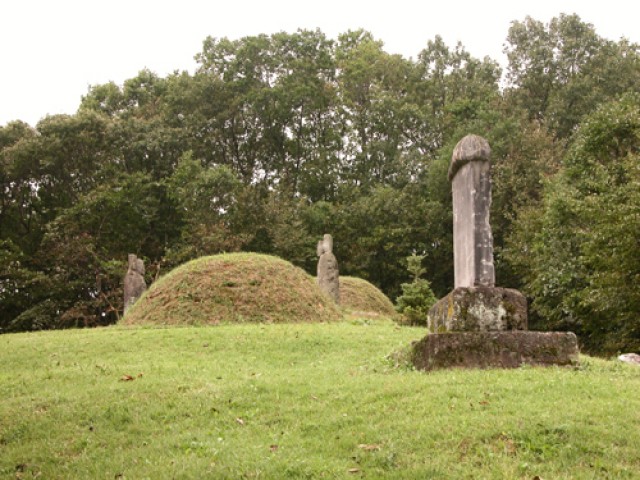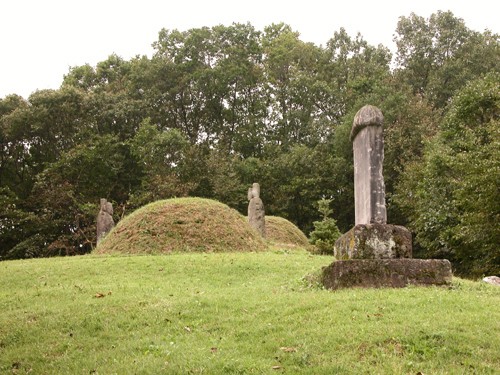RED CLOUD GARRISON, South Korea - U.S. Army installations throughout South Korea are home to some special natural and cultural resources that are protected and managed by the respective garrison's Directorate of Public Works' Environment Division and Camp Hovey is no different.
Gen. Aw Yoo-so's grave from the 15th century is located there near building T-3572. The site - hemispherical dirt mounds decorated with six stone figures - is well preserved and links back to thousands of years of Korean culture. Aw's grave is one of many natural and cultural resources on property occupied by U.S. Army Garrison Red Cloud and other U.S. Army organizations throughout the peninsula.
Designated as Dongducheon Historic Site No. 4, the original tombstone is broken and abandoned behind the grave where it is being protected. A pair of impressive stone guardians is considered artistically and historically valuable, but these were damaged by bullets at an unknown time that left holes on the back of them.
Aw's place in history is complex. It began on a cool autumn evening in Seoul in 1453 when Grand Prince Suyang, the second son of King Sejong the Great who invented the Hangeul alphabet, accompanied by a group of warriors visited Vice Premier Kim Jong-seo and handed him a letter. While Kim was reading the letter by moonlight, one of the warriors hit him on the back of the head, killing him. It was the beginning of a bloody coup d'AfAtat, known as "Gyeyu jeongnan." Suyang continued to slay his political rivals, his opponents, and even his own brothers and other relatives.
Suyang was born in 1417 as Yi Yu. Early in his life he demonstrated great ability in archery, horseback riding and the martial arts, but as the second son he did not become the crown prince. His name and title were changed to Grand Prince Suyang in 1428.
Following King Sejong's death in 1450, Suyang's ill elder brother, Munjong, ascended the throne, but soon died. The crown then passed to Munjong's 12-year-old son, Tanjong. The new king was too young and all political power was controlled by Premier In Hwang-bo and Kim.
Kim and his followers seized the opportunity of a weak teenage king to extend the power of court officials against royal family members. The tension between Kim and Suyang increased leading to Kim's assassination in October 1453.
Suyang surrounded himself with trusted allies, including his famous adviser Han Myeong-hoe, as well as Aw, which under the more recent system of Romanization used by the Korean goverment is written as Aw.
Han and Aw had advised Suyang to take over the government in a coup and supported him in this action. After the coup, Suyang arrested his brother Anpyeong, first sending him into exile, then ordering him to commit suicide.
Finally, in 1455 he forced his powerless young nephew, King Tanjong, to abdicate, declaring himself to be King Sejo. The new king named Aw as a senior general and personal advisor. Aw supported Sejo during an ensuing rebellion when Grand Prince Geumseong, and later six scholars, plotted his overthrow in an attempt to put Tanjong back on the throne.
Sejo demoted Tanjong to prince and ordered him to be poisoned. The six scholars were put to death and Aw went on to lead successful attacks on the Jurchens on the northern frontier in 1460 and 1467, the latter as the minister of defense.
For more information about this and other natural and cultural artifacts, contact the USAG Red Cloud's Environment Division at 732-6537.


Social Sharing